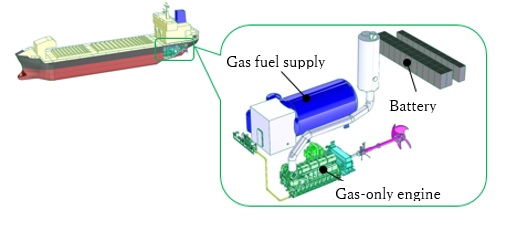

Sep. 30, 2021
Nippon Steel Corporation
Nippon Steel Cement Co., Ltd.
NS United Naiko Kaiun Kaisha, Ltd.
Japan Petroleum Exploration Co., Ltd.
Tsuneishi Shipbuilding Co., Ltd.
Kawasaki Heavy Industries, Ltd.
Nippon Steel Corporation (President: Eiji Hashimoto, Head Office: Chiyoda-ku, Tokyo),
Nippon Steel Cement Co., Ltd. (President: Yasuhiro Hashimoto, Head Office: Muroran City, Hokkaido), NS
United Naiko Kaiun Kaisha, Ltd. (President and Representative Director: Kazushi Fukuda, Head Office:
Chiyoda-ku, Tokyo hereinafter called "NSU Naiko"), Japan Petroleum Exploration Co., Ltd.
(Representative Director and President: Masahiro Fujita, Head Office: Chiyoda-ku, Tokyo), Tsuneishi
Shipbuilding Co., Ltd. (President: Sachio Okumura, Head Office: Fukuyama City, Hiroshima Prefecture), and
Kawasaki Heavy Industries, Ltd. (Representative Director, President & Chief Executive Officer:
Yasuhiko Hashimoto, Tokyo Head Office: Minato-ku, Tokyo) have agreed to construct a vessel with a hybrid
propulsion system combining a gas-only engine and a battery (hereinafter called "this Vessel")
as the replacement of the limestone carrier "Shimokita Maru" owned by NSU Naiko, and have today
signed" Memorandum of Transportation contract," "Shipbuilding contract,"
"Gas-only engine and battery propulsion system sales contract," and "Liquefied natural gas
for marine fuel sales contract."

This Vessel is scheduled to start the operation in February 2024, and will be equipped
with Japan’s first gas-only engine and total 2,847 kWh lithium-ion battery. The LNG fuel tank is
planned to use 7% nickel steel plate developed by Nippon Steel Corporation for the first time as a marine
tank. The propulsion power and the onboard electric power during the sailing are generated by the gas-only
engine developed by Kawasaki Heavy Industries, Ltd. Only natural gas will be used for high power, long
distance, and long duration navigation. The propulsion power and the onboard power during entering,
leaving and berthing ports will be provided from the battery to achieve zero-emission operation.
The CO2 emission reduction effect of introducing the propulsion system of this vessel is 23.56% (about 30%
at normal load operation) compared to the conventional vessels of the same type, and the exhaust gas of
the gas-only engine contains almost no SOx, and NOx emissions is far below the TierⅢ standards.
In addition, on its main routes, the loading port, Shiriyamisaki (Aomori Prefecture) and the unloading
port, Muroran (Hokkaido), the zero-emission operations that are friendly to the environment will be
carried out.
The construction of this Vessel was adopted by the Global Environment Bureau of the Japanese Ministry of
the Environment and the Maritime Bureau of the Japanese Ministry of Land, Infrastructure, Transport and
Tourism for the "Projects to promote the introduction of advanced technologies that will
simultaneously achieve social innovation and the decarbonization of logistics (Projects to promote the
introduction of LNG fuel systems, etc.)" FY2021 Subsidy for the expenses in projects for measures to
suppress carbon dioxide emissions.
<Overview of the successor ship to the Shimokita Maru>
Deadweight tonnage (DWT): approximately 5,560 tons
Total length: approximately 93.8 m
Molded breadth: approximately 18.2 m
Molded depth: approximately 9.9 m
Scheduled Delivery: Early February 2024
Propulsion system: Hybrid system of gas-only engine (8L30KG) and battery
Shipyard: Tsuneishi Shipbuilding
Liquefied natural gas supplier: Japan Petroleum Exploration
Main route/Cargo: Shiriyamisaki - Muroran /Limestone
<Roles of each company>
Shipcharterer:Nippon Steel Corporation and Nippon Steel Cement
Shipowner/Operator: NS United Naiko Kaiun Kaisha, Ltd.
Propulsion system: Kawasaki Heavy Industries
Shipyard: Tsuneishi Shipbuilding
Liquefied natural gas supplier: Japan Petroleum Exploration